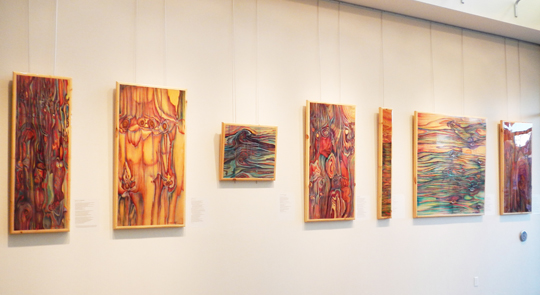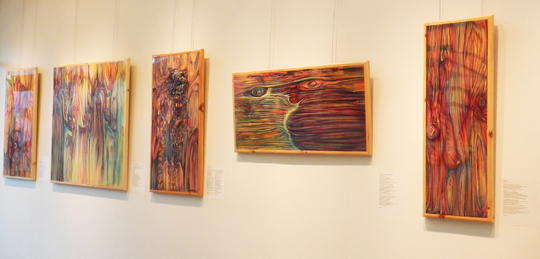- The Circle Unfolds - First Nations Education in Canada, Willie Ermine Cree Elder and Scholar


Exhibition at Collingwood Library
I go back to the lexicons of our ancestors to define this old/new work. The word mamatowisowin allows me to see and develop my understandings of my work in the language that my ancestors saw life, a relationship to its existence. This unique art practice requires the inwardness necessary to utilize, holistically, all that constitute the creative being; not only the physical and intellectual, but also the emotional and spiritual. Trees become my own subjective exploration into my ancestry and culture. Like the Petroglyphs, it is through their life, and following the growth of their grains of wood with washes of Acrylic, that causes me to trust in mother earth, universe, spirit and self as a means of pro-creation.
In a traditional sense, natural elements from Mother Earth have always been our template for how we live, giving us stories or defining our culture, our rituals, our cycles, our sacred spaces and practices, our structure, our meaning for life. Here I parlay the grains from the inside creation time of the tree, the Standing People. Plied flat and glued onto board, it is their creation that defines my voice, my work. This becomes a template into my mind's eye, their spirit telling me what is. I am spiritually moved and humbled by this process of, discerning meaning from the insides of the tree, connecting me to something greater.
But in a contemporary world, plywood by its very creation has its life of lines frozen for all time, into a snapshot of its growing time. Its spirit ignored in hardware stores, used constructively to build homes, as a barricade against Mother Earths elements, or to prop us up away from the earth in beds and chairs and tables, holding us aloof from what sustains us.
The process of creating this work on wood is quite different from mainstream art, where the end is visualized then actualized in its completion. This way of painting evolves into what it will, unfolding a greater inherent understanding of what was always there, not planned out, but rather trusted, intuited, spontaneously instinctually rebirthed into a new complex being connected to my microcosm. I intuit the grains with brush, water and acrylic to find what my heart and mind are seeking. I am seeking mamatowisowin. Only sometimes am I deviating from what the tree grew with random inspired images added to this story. Transparently, layer after layer I am washing colour into its life, taking a deeper understanding, into what I am finding, as I am searching inside layer after layer, in sensitivity to her spirit connected to mine. I seek out wood panels for how their wood grain imagery resonates with my heart, spirit and mindful eye, but it is later when the imagery unfolds a shared dreamscape, that I find meaning inside myself, from the spiritual spaces of that connection to the visionary journey of her grains.
The 1973 book Sacred Art of the Algonkians - A Study of the Peterborough Petroglyphs by Joan M. Vastokas and Romas K. Vastokas, Mansard Press, Peterborough illuminates this new but very old art practice, connected into the 'life force' of the rock, as a means of procreation:
But these natural configurations in the rock did not merely provide a surface format. They became, in fact, part of the pictorial imagery itself. In the case of many individual glyphs, as we have already seen, the hollows and crevices either suggested an image to the carver or were incorporated into and fused with the subject matter of the glyphs. In other words, the rock surface has become part of the visual image, nature has been transformed into a work of art. The glyphs, therefore, do not exist in a random, non directional space. They are disposed and positioned in keeping with the natural features of a particular rock outcropping and, in many instances, are made integral with their natural setting. This observation cannot be over-emphasized, because the disposition of pictorial images in prehistoric art sites elsewhere has been frequently described as chaotic, without spatial direction, and as failing to obey any principles of human ordering or composition. Closer inspection, however, suggests otherwise. Although the Peterborough Petroglyphs do not reveal any hieratic, narrative, or geometrical compositional arrangements, they are not devoid of any order whatsoever. In fact, the relationship between the artist and his medium revealed at this site, is one of total cooperation between man and Nature; the artist works with, rather than impose himself upon the natural environment, a fact that discloses a great deal about the artist's culture, about Algonkian world view and mythology.
The absence of an imposed scheme upon Nature, however, does not constitute 'primitive characteristics', nor can the principle of pictorial harmony with Nature be deemed a developmental mode of artistic composition. Rather the arrangement of images must be seen as embodying, expressing and communicating the relationship between the artist and his medium, between culture and Nature. European works of art have most often obeyed the principle of simultaneity both of creation and experience; the work is planned and executed from the beginning as a single unified composition, a composition, moreover, that is conceived by an artist or team of artists, working from a uniform scheme. The observer is likewise urged to experience that work in its entirety, as an undivided whole within which all elements combine to communicate a specific event in time or a sequence of related moments.
If the glyphs are to be experienced as being at one with the rock both physically and iconographically, then the site itself must be perceived as integral with its landscape setting and surrounding space. In Algonkian ideology, as we have seen, space itself is not without form, it is charged with meaning, structured, and differentiated in terms of axial directions, sacred centres, and degrees of supernatural potency. The choice of the limestone surface rather than an animal hide or a piece of bark upon which to render sacred images attests to the fact that the rock itself is a sacred object and embodies in itself a concentration of Manitou. It is also a microcosm of the universe, a spiritual sanctuary, and archetypal temple. To have painted or carved the individual images on another medium would have been a meaningless irrelevant act. To fully apprehend this remarkable site, therefore the Algonkians sense of place, their feeling for the potency, oneness and sacredness of natural phenomena must be realized. This form of sacred art is an outgrowth and expression of reverence and respect for nature in all its manifestations, for nature's landmarks of special and spiritual meaning. Images are carved on this rock because here the spirits have their abode, they are assembled at this place because its natural and physical qualities evoke the very structure of the universe: here the upper and the lower worlds meet at the centre of the universe. Among the Algonkians, therefore and at this site in particular, art cannot be readily separated visually or iconographically from nature. The images engraved here are not the projections of man, imposing his will upon his surroundings. Instead, they render visible the hidden meanings in nature whose significance it has been the shaman's task to conjure up and capture on stone.
I am not a shaman but a spiritual human being wanting to bring about a better world. Ultimately I want to bring awareness to a deeper way of seeing, a spiritual education from the heart that brings one closer to Mother Earth and self.


